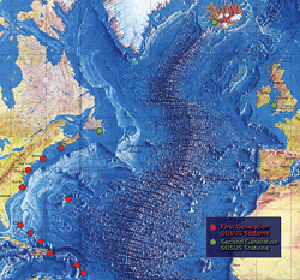
Back SOSUS Danish Sound Surveillance System German SOSUS Spanish SOSUS Estonian Sound Surveillance System French SOSUS ID SOSUS Italian SOSUS Japanese SOSUS Korean SOSUS NN

Sound Surveillance System (SOSUS) was the original name for a submarine detection system based on passive sonar developed by the United States Navy to track Soviet submarines. The system's true nature was classified with the name and acronym SOSUS classified as well. The unclassified name Project Caesar was used to cover the installation of the system and a cover story developed regarding the shore stations, identified only as a Naval Facility (NAVFAC), being for oceanographic research. The name changed to Integrated Undersea Surveillance System (IUSS) in 1985, as the fixed bottom arrays were supplemented by the mobile Surveillance Towed Array Sensor System (SURTASS) and other new systems. The commands and personnel were covered by the "oceanographic" term until 1991 when the mission was declassified. As a result, the commands, Oceanographic System Atlantic and Oceanographic System Pacific became Undersea Surveillance Atlantic and Undersea Surveillance Pacific, and personnel were able to wear insignia reflecting the mission.

The original system was capable of oceanic surveillance with the long ranges made possible by exploiting the deep sound channel, or SOFAR channel. An indication of ranges is the first detection, recognition and reporting of a Soviet nuclear submarine coming into the Atlantic through the Greenland-Iceland-United Kingdom (GIUK) gap by an array terminating at NAVFAC Barbados on 6 July 1962. The linear arrays with hydrophones placed on slopes within the sound channel enabled beamforming processing at the shore facilities to form azimuthal beams. When two or more arrays held a contact, triangulation provided approximate positions for air or surface assets to localize.[note 1]
SOSUS grew out of tasking in 1949 to scientists and engineers to study the problem of antisubmarine warfare. It was implemented as a chain of underwater hydrophone arrays linked by cable, based on commercial telephone technology, to shore stations located around the western Atlantic Ocean from Nova Scotia to Barbados. The first experimental array was a six-element test array laid at Eleuthera in the Bahamas in 1951, followed, after successful experiments with a target submarine, in 1952 by a fully-functional 1,000 ft (304.8 m), forty-hydrophone array. At that time the order for stations was increased from six to nine. The then-secret 1960 Navy film Watch in the Sea describes the production arrays as being 1,800 ft (548.6 m) long. In 1954, the order was increased by three more Atlantic stations and an extension into the Pacific, with six stations on the West Coast and one in Hawaii.
In September 1954, Naval Facility Ramey was commissioned in Puerto Rico. Others of the first Atlantic phase followed, and in 1957 the original operational array at Eleuthera got an operational shore facility as the last of the first phase of Atlantic systems. The same year, the Pacific systems began to be installed and activated. Over the next three decades, more systems were added; NAVFAC Keflavik, Iceland in 1966 and NAVFAC Guam in 1968 being examples of expansion beyond the western Atlantic and eastern Pacific. Shore upgrades and new cable technology allowed system consolidation until by 1980 that process had resulted in many closures of the NAVFACs with centralized processing at a new type facility, Naval Ocean Processing Facility (NOPF), that by 1981 saw one for each ocean and mass closing of the NAVFACs.
As the new mobile systems came on line, the original arrays were deactivated and some turned over for scientific research. The surveillance aspect continues with new systems under Commander, Undersea Surveillance.
Cite error: There are <ref group=note> tags on this page, but the references will not show without a {{reflist|group=note}} template (see the help page).